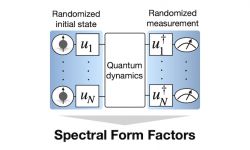
A class of observables known as partial spectral form factors can efficiently measure signatures of chaos in existing quantum simulators, opening the door to future insights into chaos and thermalization.
Several complex systems of many particles show surprisingly simple and universal behaviors that are generally independent of the details of the initial state after evolving for some time. This is the phenomenon of thermalization, typically seen in chaotic systems. At the quantum level, such systems show characteristic signatures in the statistical properties of their energy eigenlevels and eigenstates that distinguish them from nonchaotic systems. Physicists led by Peter Zoller propose a method to efficiently measure these signatures in existing many-body quantum simulators, using a class of observables called partial spectral form factors.
A central theme underlying their work is the idea that randomness can lead to apparent universal behavior when ignoring finer details. Thermalization in chaotic systems is generally considered to be due to dynamics that effectively looks random after some time. “The corresponding signatures of chaos are therefore distributions of energy eigenlevels and eigenstates that are associated with random dynamics, which we show that the partial spectral form factors can reliably identify”, says Lata Kh Joshi.
More directly, the proposed method is based on the framework of randomized measurements: The dynamics of the system is investigated via randomly generated initial states and measurements, so that the universal features of the dynamics can be readily extracted without significant nonuniversal effects from specific states and measurement settings.
The techniques used here could be extended to more detailed probes of quantum dynamics, including in devices affected by noise and decoherence. Additionally, a theoretical analysis of partial spectral form factors in different systems may lead to further insights into the physical mechanism behind chaos and thermalization and perhaps shed more light on connections to quantum gravity.